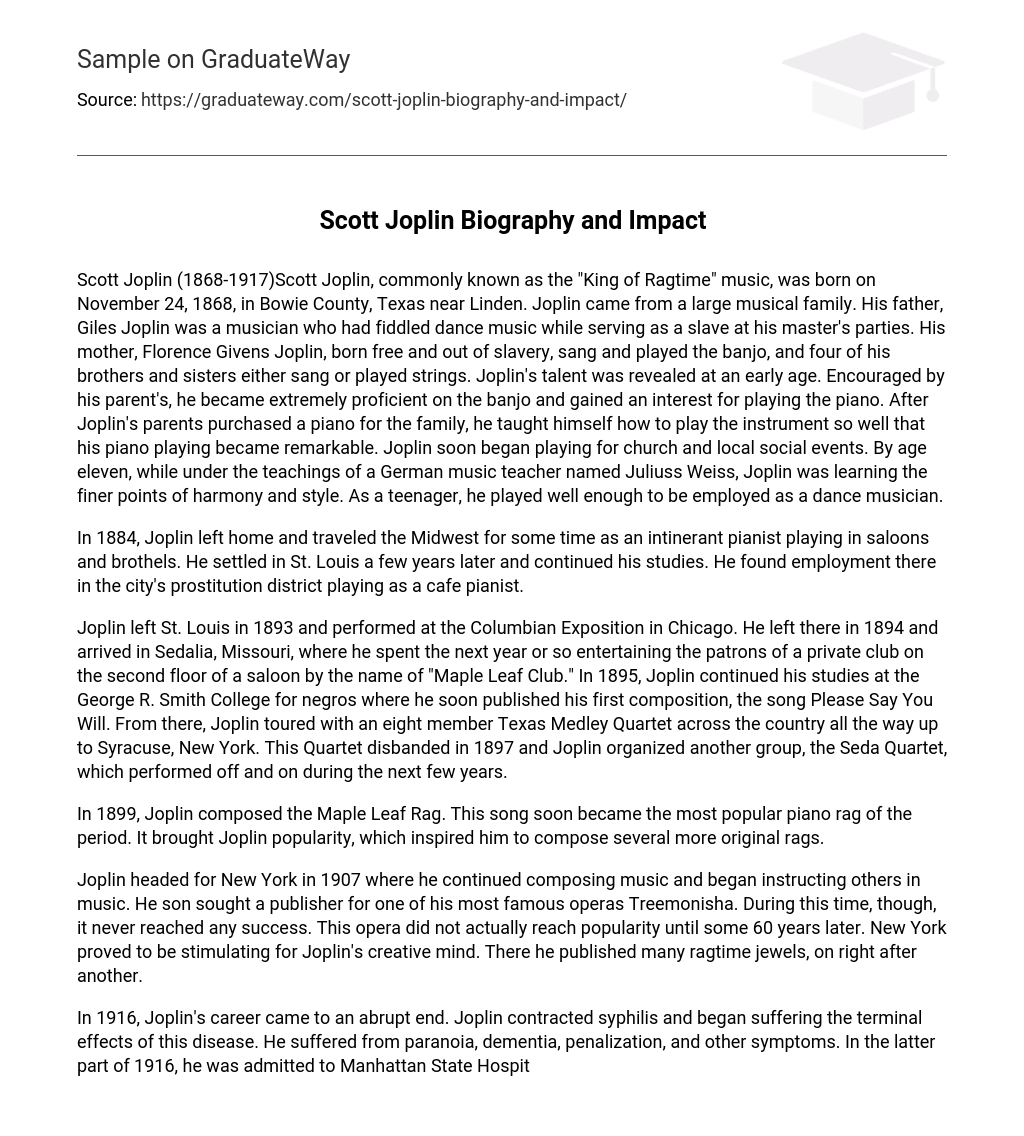Scott Joplin, known as the “King of Ragtime” music, was born on November 24, 1868, in Bowie County, Texas near Linden. He came from a large musical family – his father, Giles Joplin, played dance music as a slave and his mother, Florence Givens Joplin, sang and played the banjo. Four of his siblings also had musical talents.
Joplin himself showed early musical talent. Inspired by his parents’ example, he became skilled at playing the banjo and developed a deep love for the piano. When his parents bought a piano for their home, he taught himself to play it exceptionally well. Soon after that, he started performing at church services and local social events. At eleven years old, he began taking lessons from Juliuss Weiss – a German music teacher – who taught him about harmonies and style elements. As he grew older, people recognized his talent more and more and he found work as a dance musician.
In 1884, Joplin began traveling in the Midwest as a pianist, performing in saloons and brothels. Later on, he chose to establish himself in St. Louis and continue his musical education. Ultimately, he obtained a job as a pianist in the area of the city specifically dedicated to prostitution.
Joplin displayed his talents at the Columbian Exposition in Chicago in 1893, after leaving St. Louis. He then left Chicago in 1894 and eventually arrived in Sedalia, Missouri. While there, he entertained audiences at the “Maple Leaf Club,” a private club located on the second floor of a saloon.
In 1895, Joplin enrolled at George R. Smith College for negros and quickly published his first work, the song “Please Say You Will.” Following this achievement, Joplin embarked on a nationwide tour with the Texas Medley Quartet consisting of eight members until they disbanded in 1897.
Subsequently, Joplin formed another group called the Seda Quartet that occasionally performed in the following years.
In 1899, Joplin wrote the Maple Leaf Rag, which quickly became the most acclaimed piano rag of its time and propelled him to fame. This success motivated Joplin to create numerous additional original rags.
In 1907, Joplin went to New York, where he continued composing music and started teaching music as well. Meanwhile, his son tried to find a publisher for his famous opera Treemonisha, but it didn’t achieve success at that time. However, it took about 60 years for this opera to gain popularity. Joplin found New York to be inspiring for his creativity, and he published numerous ragtime pieces there, one after another.
Scott Joplin’s career came to an abrupt end after contracting syphilis in 1916. The disease caused severe effects including paranoia, dementia, and penalization. As a result, he was admitted to Manhattan State Hospital, a mental hospital where he stayed until his death on April 1, 1917. After his passing, Joplin was buried at St. Michael’s Cemetery in the Astoria region of Queens, New York.
Despite his undeniable talent as a composer, Joplin did not receive the recognition he deserved during his career. This was largely because black musicians had limited opportunities to have their music heard by serious musicians at that time. However, after his death, Joplin’s music gained acknowledgement due to the resurgence of ragtime music in the 1970s and its popularity in the 1920s and 1930s.
Throughout his life, Joplin’s musical skills were deeply influenced by his musician parents. He not only absorbed their influence but also shared it with others, inspiring fellow musicians, students, and those who studied his music.
Joplin pioneered the creation of ragtime, a music genre that fused European classical styles with African American rhythm and harmony. Over the course of his life, Joplin released around 60 compositions, with 41 of them being piano rags. He was renowned for his distinct styles, particularly in developing the piano rag and American folk operas. His success primarily stemmed from blending Afro-American folk traditions with European art music forms and techniques.
Joplin, a renowned artist, created numerous remarkable works of art. Among his most renowned pieces are The Great Crush Collision, Maple Leaf Rag, The Entertainer, Ragtime Dance, and Treemonisha. Interestingly, most of these works gained popularity many years after Joplin’s death.
Joplin’s early composition, The Great Crush Collision, was created in late 1896. The piece was influenced by a significant train crash that occurred near Waco, Texas in September of that year.
Maple Leaf Rag, completed in 1899, became Joplin’s most renowned rag and earned him the title “King of Ragtime.” Additionally, it served as a consistent source of income through royalties. The name of the rag originated from the Maple Leaf Club, a dance hall where Joplin worked in 1895.
The Entertainer, finished in 1902, became one of Joplin’s most well-known works. It gained him immense popularity and fame after he died when it was featured in the award-winning film The Sting in 1974.
Ragtime Dance, which was completed by Joplin in 1902, was written as a preliminary sketch for a ragtime opera titled A Guest of Honor composed shortly thereafter.
In May 1911, Joplin published his renowned opera ‘Treemonisha’, a 240-page manuscript written for eleven voices with piano accompaniment. This groundbreaking piece became the first grand opera composed by an African American. In 1976, ‘Treemonisha’ was honored with the prestigious Pulitzer Prize.
The 20-volume publication The New Grove Dictionary of Music and Musicians, edited by Stanley Sadie, was published in London by Macmillan in 1980 (volume 9: pages 708-709).
Baker’s Biographical Dictionary of Musicians, edited by Nicolas Slonimsky, is the seventh edition. It was published by Macmillan in New York in 1984 (pages 1135-1136).
The Biographical Dictionary of Afro-American and African Musicians, edited by Eileen Southern, can be obtained from Greenwood Press in Connecticut (pages 220-222).
Published by W.W. Norton and Co. in New York, The Dictionary of American Negro Biography is located on pages 369-371.





